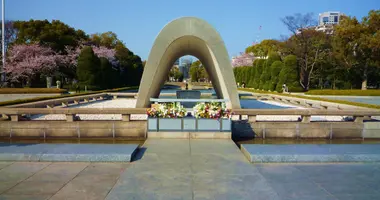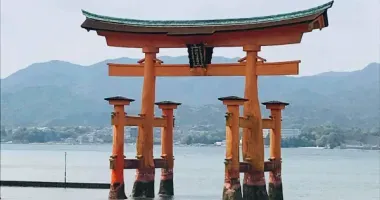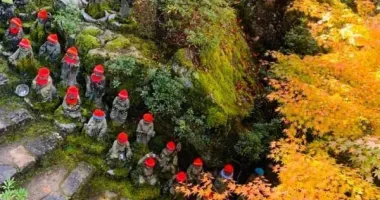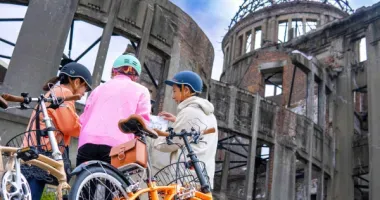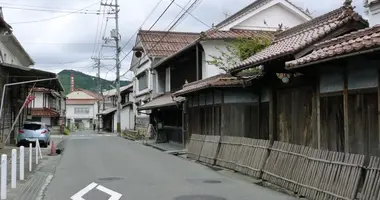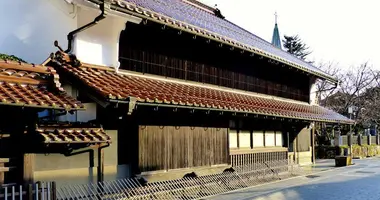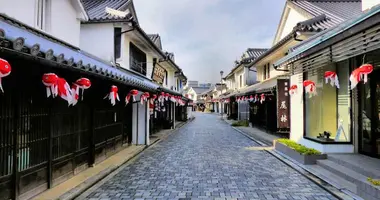Innoshima Guide
Innoshima is a small island of just under 40 square kilometers in the Seto Inland Sea between Honshu and Shikoku known as the home of the Murakami pirates.
- Innoshima Suigun Castle
- Other Innoshima Attractions
- Innoshima Festivals
- Accommodation on Innoshima
- Access
- Japan City Guides
Innoshima 因島
Innoshima is a small island of just under 40 square kilometers in the Seto Inland Sea between Honshu and Shikoku. Innoshima has a population of about 27,000 people, and since 2006 has been incorporated into Onomichi City, Hiroshima Prefecture.
 Innoshima Bridge & the view of the Inland Sea
Innoshima Bridge & the view of the Inland Sea
As with all Japanese islands, fishing is an important economic activity on Innoshima, but there is also agriculture, especially citrus fruit, and even some industry in the form of ship building.
It is often forgotten that Japan is comprised of thousands of islands, many hundreds of them inhabited, and life on these smaller islands is a far cry from the hectic bustle of the modern cities like Tokyo, Kyoto and Hiroshima that attract most tourists.
While many of these small islands still remain fairly inaccessible, served only by small, infrequent ferries, some, like Innoshima, have become connected to the mainland by modern bridges. Innoshima is on the Shimanami Kaido, a 60 kilometer road that connects Honshu with Shikoku by a series of bridges connecting eight islands.

Ikuchi Bridge
Innoshima is the second island going from Onomichi in Hiroshima to Imabari in Ehime on Shikoku and is connected to the first island, Mukaijima, by the Innoshima Bridge, a suspension bridge with a main span of 770 meters, completed in 1983.
Ikuchijima, the third island is reached from Innoshima via the Ikuchi Bridge, a cable-stayed bridge with a main span of 490 meters completed more recently in 1991. While most drivers using the Shimanami Kaido do not stop off on any of the islands, simply using the expressway to get to and from Shikoku, the bridges are unusual in that they have lanes for pedestrians and cyclists, and among cyclists the route has become very popular. Their journeys cannot use the expressway, so often include visits to sites on the islands.
 Murakami Suigun Castle, Innoshima
Murakami Suigun Castle, Innoshima
Innoshima Suigun Castle Museum, Innoshima
Murakami Suigun Castle
The main draw on Innoshima is the Innoshima Suigun Castle ("Innoshima Navy Castle"). The Murakami clan are either called pirates or a navy, the distinction being somewhat fluid, but what is certain is that they ruled the waterways of the Seto Inland Sea, a major transport artery, for several centuries.
There were three branches of the clan, one based here on Innoshima the other two on Kurujima Island and Noshima Island. Descendants of the Seiwa Genji through Minamoto no Yorinobu, the three clans are believed to be based on three brothers who adopted the name Murakami in the 11th century.
In the 16th century the Ashikaga Shogunate gave the Murakami official control of the area as reward for their military support. During the Sengoku (warring states) Period, the Murakami were supporters of the Mori clan in their rise to regional power.
As part of the Mori navy, the Murakami were defeated by Oda Nobunaga who had employed Tekkosen, iron-reinforced ships, against them. Following the rise to power of Hideyoshi, the Innoshima Murakami took part in his unsuccessful invasion of Korea, but in the years after, Hideyoshi outlawed their money-making ventures of extracting tolls and taxes from Inland Sea shipping, and their fortunes waned.
The "castle" on Innoshima was constructed in 1983, and is in reality not even a reconstruction, rather a complete reimagination. There were fortifications all around the perimeter of the island, but what stood at the current site was probably no more than a watchtower, to command views over the surrounding seas, and a few rudimentary huts.
The buildings contain a museum displaying aspects of the Murakami and their rule over the area. One room is a full size tableau of samurai meeting with their master. Many of the displays have English explanations. Visitor are invited to try on samurai armor and helmet for photo ops. A short path leads to a viewpoint with expansive views looking back to the castle and over the island.
The castle is open from 9.30am to 5pm, closed Thursdays (except when Thursday falls on a national holiday) and Dec 29-Jan 1. Entry is 310 yen for adults.
Innoshima Suigun Castle
3228-2 Nakanosho-cho, Innoshima, Onomichi, Hiroshima.
Tel: 0845 24 0936
 Tableau of samurai meeting with their master, Murakami Suigun Castle Museum, Innoshima
Tableau of samurai meeting with their master, Murakami Suigun Castle Museum, Innoshima
500 Rakan on top of Mount Shirataki, Innoshima
Other Innoshima Attractions
As well as the castle and the beach, there are plenty of other things to see and do while exploring the island. The Innoshima Flower Center at the foot of Mt. Shiratake is a free attraction with more than 300 botanical species, including tropical plants and fruit. Tel. 0845-26-6212. 9am-5pm. Closed Tuesday and Dec 29-Jan 1.
Every April there is a miniature Innoshima Pilgrimage of 88 Sacred Sites that many people from outside the island participate in over about three days, walking the 84 km trail, much like the bigger and more famous Shikoku Pilgrimage nearby. But the best thing to do is to climb the highest point on the island, Mount Shirataki, only 227 meters high, but commanding a full 360 degree view over the islands dotted around the surrounding Inland Sea.
 The view from Mount Shirataki, Innoshima
The view from Mount Shirataki, Innoshima
On top of Mt. Shirataki is a small Kannon temple here called Yakuriji, built by the Murakami; but what is more special are the almost 700 statues and rock carving that cover the mountaintop. There are the usual assortment of Buddhas, and a set of nice carvings of Tengu, the long-nosed mountain goblins, but the main draw is the 500 Rakan - rock carvings of the 500 disciples of the Buddha.
Every single rakan features a different face. They were carved at the end of the Edo Period by a local man, Denroku Kashihara, and his protoges, and their lack of sophistication only enhances their expressiveness. The temple and statues on the peak are free to visit, and a visit around sunset will reward the little effort needed. There is a car park 5 minutes from the top, or a footpath from the western side of the mountain.
Innoshima is the birthplace of Honinbo Shusaku (1829-1862), a legendary go-player from the 19th century. The Honinbo Shusaku Igo Memorial Hall honors the man and the island hosts two Shusaku Honinbo Go Festivals every year.
Innoshima is also the birthplace of the two members of the Japanese rock band Porno Graffitti (sic), formed in 1999, with tours offered to fans of the entertainers' birthplaces and favorite spots.
From the southern end of the island there are a couple of small ferries out to other smaller islands from Habu Port.
Innoshima Festivals
The Murakami feature heavily in the summer festivals of the island, the first being the Island Festival held either at the end of July or early August - featuring a parade of warriors, followed by a ceremony at Kinren Temple, and then a firework display.
The Fire Festival and the Sea Festival take place later, at the end of August, on consecutive days. The Fire Festival takes place on Shimanami Beach and features dancing and parades culminating is the fire festival itself, with huge burning brands, followed again by fireworks.
The following day is the Sea Festival, also on Shimanami Beach, and the main event is boat racing featuring Kohaya boats, replicas of the small, fast boats used by the Murakami. Each boat has a team of 16 rowers, and there are up to 50 different teams. Visitors can also try their hand at rowing a Kohaya.

Kohaya boat race, Innoshima, Hiroshima Prefecture On top of Mount Shirataki, Innoshima
On top of Mount Shirataki, Innoshima
Accommodation on Innoshima
There are not a lot of accommodation options on Innoshima, just a few guest houses and the Daihamasaki camping ground.
Access - Getting to Innoshima
Local buses run out to Innoshima from Onomichi and Imabari.
Onomichi is on the JR Sanyo Line, 20 minutes from Fukuyama, 90 minutes from Hiroshima, or 70 minutes from Okayama. Shinonomichi is a shinkansen station but only the slow Kodama trains stop there. There are buses from Shinonomichi into the town but it is easy to get off the shinkansen in Fukuyama and take a local train from there.
Ferries from Onomichi go to many of the islands in the Inland Sea as well as to Imabari in Shikoku and Tomonoura near Fukuyama. One of the most popular ferries is to Setoda on Ikuchijima. Several ferries frequently cross the narrow waterway to Mukaijima.
Onomichi is 1 hour & 40 minutes from Osaka by shinkansen.
Visitors to Onomichi should also visit Onomichi Castle, a replica castle erected in 1964.

